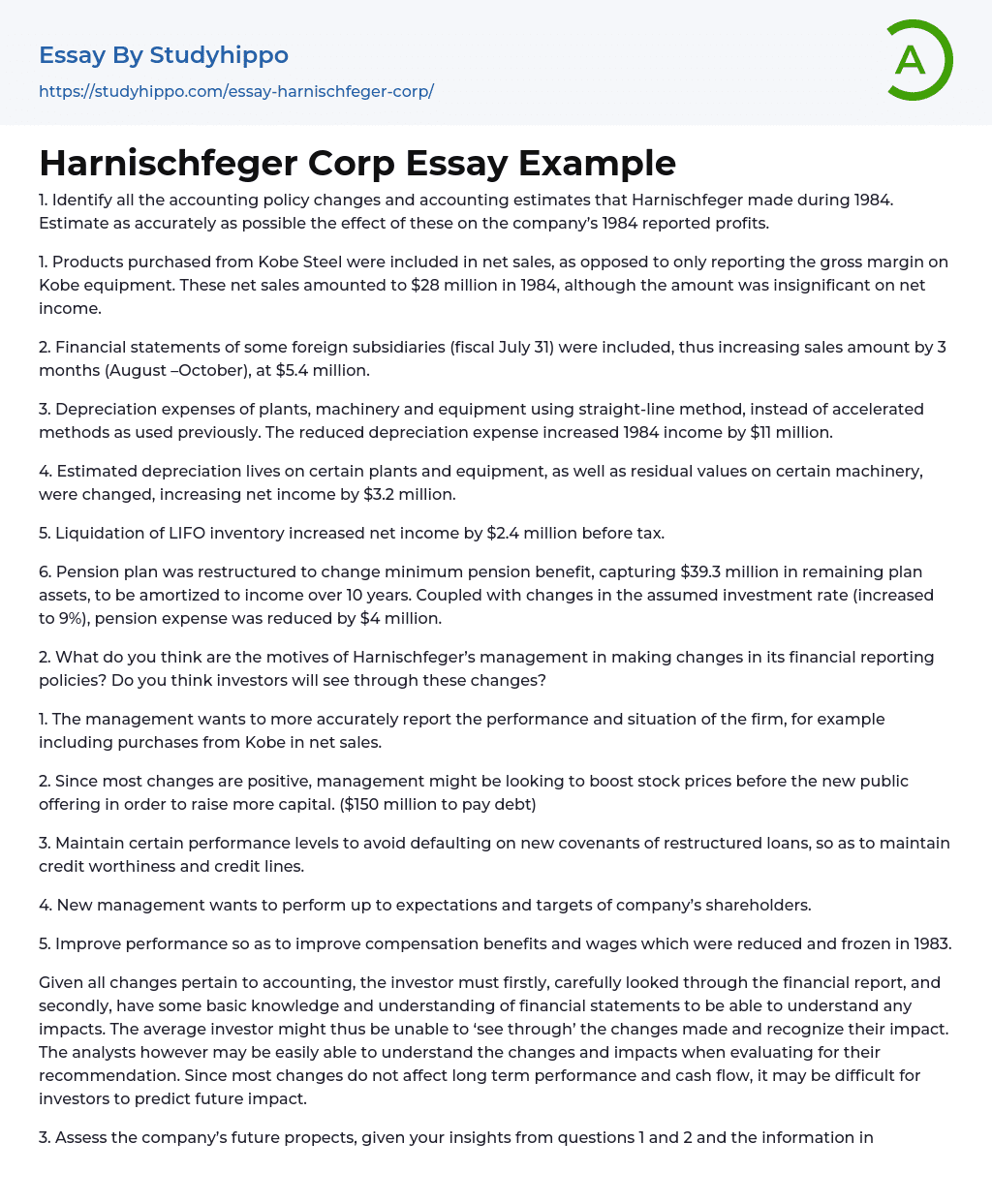1. Recognize all alterations made in accounting policies and accounting predictions that Harnischfeger executed during 1984. Try to gauge as precisely as you can the influence these revisions had on the company's declared earnings for 1984.
1. Kobe Steel's products, which were accounted for in the net sales, led to a total of $28 million in 1984, even though their contribution to the net income was trivial. This was in contrast to merely including the gross margin from Kobe equipment.
2. The financial reports of several overseas subsidiaries (financial year ending July 31) were incorporated, leading to a rise in sales figures by three months (August to October), totalling $5.4 million.
3. The plants, machinery, and equipment depreciation costs utilized the straight-line method, replacing the formerly used accelerated methods. This shift resulted in reduced depreciation expenses, thus r
...aising the 1984 income by $11 million.
4. The projected lifespan of depreciation for some plants and equipment, along with the remaining worth of specific machinery, were adjusted, resulting in a $3.2 million rise in net income.
The dissolving of the LIFO inventory contributed to a rise in the net income by $2.4 million before tax deductions.
6. The pension scheme underwent restructuring which altered the minimum pension benefit and secured $39.3 million from the remaining plan assets that are set to be amortized into income over a decade. This, along with amendments to the assumed investment rate (raised to 9%), contributed to a decrease in pension expenses by $4 million.
2. What are your thoughts on the reasons behind Harnischfeger's management modifying its financial reporting protocols? Do you believe investors will recognise these alterations?
1. The administration seeks t
present the company's status and operations more precisely, such as incorporating purchases from Kobe into net sales.
2. Given that the majority of alterations are beneficial, it's possible that the management is aiming to escalate the stock prices prior to the fresh public issue so as to garner more funding. ($150 million for debt repayment)
3. Uphold specific performance standards in order to prevent breaching the newly restructured loan terms' conditions, thereby ensuring the maintenance of credit worthiness and credit lines.
4. The new leadership aims to meet the goals and aspirations of the company's stakeholders.
5. Enhance productivity to boost compensation benefits and salaries that were cut down and stopped in 1983.
Every alteration that involves accounting mandates that the investor initially scrutinizes the financial report meticulously, and subsequently, possess a rudimentary comprehension of financial declarations to discern any ramifications. Consequently, it might be challenging for an ordinary investor to perceive the modifications implemented and acknowledge their outcomes. In contrast, analysts could readily comprehend these alterations and their effects while formulating their suggestions. Considering that most modifications do not influence long-term performance and cash flow, forecasting future effects could become arduous for investors.
3. With the insights from questions 1 and 2 and the company’s turnaround strategy information provided in the case, evaluate the future prospects of the company.
The recovery plan comprised four key aspects – modifications in senior leadership, cutback on costs, repositioning of the business approach, and finally, debt reorganization and recapitalization. Each aspect appears to have been successful, as the new management was able to put into action measures that quickly led to a positive turnaround for the company. The business reorientation
permitted it to pivot its attention to sectors with greater value and potential for swift growth, while cost reductions successfully boosted profit margins. The company’s financial situation remained robust and the confidence of investors paved the way for seamless recapitalizations, aiding in settling any residual debts.
The takeaway from question 1 suggests that the majority of the influence on profit appears to be ephemeral, with some alterations presenting negligible impact. Therefore, the ameliorated performance of the company doesn't seem to be necessarily a byproduct of accounting alterations. From question 2, a theory arises that management could have embedded incentives such as, compensation, or be under strain to enhance and sustain performance (for instance loan covenants). Nonetheless, compensation structures and loans could have been adjusted to prevent improvements solely attributed to accounting modifications. Hence, all motives might be oriented towards a common goal of legal performance enhancement. With these factors under consideration, an optimistic projection for the company's future is plausible.
- Accounting essays
- Marketing essays
- Automation essays
- Business Cycle essays
- Business Model essays
- Business Operations essays
- Business Software essays
- Corporate Social Responsibility essays
- Infrastructure essays
- Logistics essays
- Manufacturing essays
- Multinational Corporation essays
- Richard Branson essays
- Small Business essays
- Cooperative essays
- Family Business essays
- Human Resource Management essays
- Sales essays
- Market essays
- Online Shopping essays
- Selling essays
- Strategy essays
- Management essays
- Franchising essays
- Quality Assurance essays
- Business Intelligence essays
- Corporation essays
- Stock essays
- Shopping Mall essays
- Harvard Business School essays
- Harvard university essays
- Trade Union essays
- Cooperation essays
- News Media essays
- Waste essays
- Andrew Carnegie essays
- Inventory essays
- Customer Relationship Management essays
- Structure essays
- Starting a Business essays
- Accounts Receivable essays
- Auditor's Report essays
- Balance Sheet essays
- Costs essays
- Financial Audit essays
- International Financial Reporting Standards essays
- Tax essays
- Accountability essays
- Cash essays
- Principal essays




